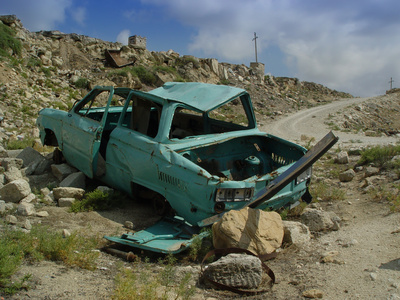Maintaining a car in operating condition, whether new or old, requires close attention to the car's safety systems. It is advisable to periodically subject your vehicle to a safety inspection, and while the most thorough inspection would be performed by a professional, following are some basic do-it-yourself checks. These are the most basic points of inspection, but are essential to the safe operation of the vehicle.

While it is generally understood that adequate tread on tires is essential to a car's safe operation, many are unaware that properly inflated tires are equally important and contribute greatly to your car's gas mileage. To check tread level, insert a penny into the center tread. If the penny goes into the tread deeper than the top of Lincoln's head, the car is in need of new tires. To evaluate tire air pressure, consult the vehicle owner's manual for the correct PSI, or pounds per square inch. Insert a tire gauge (digital is best) into the tire's valve stem, and add or release air as necessary. Repeat both exercises with all four tires. If the vehicle has a full-size spare, check it as well.

It is difficult (if not impossible) to accurately visually inspect brakes without the use of a lift, so you will need to evaluate brakes based on the "feel" via the foot pedal, as well as the car's stopping ability. Are the brakes firm when you depress the pedal and immediately responsive? Good. "Spongy" and with a slow response time? Bad.

With the key turned to the "ACC" position (allowing operation of electrical accessories in the vehicle, but without engaging the engine), turn the headlights to the "on" position. Walk around the car from the outside to ensure that all lights (front and rear) are functional and illuminated. Activate the turn indicators and repeat, making certain that all directional lights are operational. Sitting in the vehicle, depress the brake pedal and have a partner outside the vehicle ensure that all brake lights are operational. Finally, shift the transmission into "reverse" (keep your foot on the brake!) and have a partner outside the vehicle verify that the backup warning lights illuminate.

Before checking fluid levels, inspect under the vehicle for obvious signs of leaks (puddles of fluid or stains on the concrete). Open the engine bay and check the level of all of the vehicle's fluids--brake, radiator, oil, power steering, window washing, etc. Adjust the fluid level as necessary, and take care to use the correct types of fluid for the vehicle; consult the vehicle owner's manual for more specific information related to your make and model.
Note: If you observed signs of a leak in one of your vehicle's fluids, check your fluid levels daily to determine which fluid is leaking, and seek professional assistance in its repair.

This is likely the easiest inspection to perform. Walk the outside of the vehicle to ensure that all of the glass--windshield, rear window, side windows--are free from cracks or serious pitting. Inspect the vehicle's side mirrors for cracks and, if the mirrors are electric, inspect from the interior of the vehicle to make certain that they respond to electrical adjustments. Also ensure that the rearview mirror is free of cracks and is able to be positioned appropriately.

Inspect all seat belts to make certain that they latch securely and tension appropriately. Sound the horn to ensure that it is responsive and functional. Turn the car on and with the engine running check the dash for any "warning" lights that may indicate a problem with the vehicle's systems. Ensure that the front driver's and passenger's side seats are fully adjustable in regards to their range of motion. With the car running, test the car's windshield wipers in all operating speeds; while the wipers are running, ensure that the wiper blades are in operational condition.
